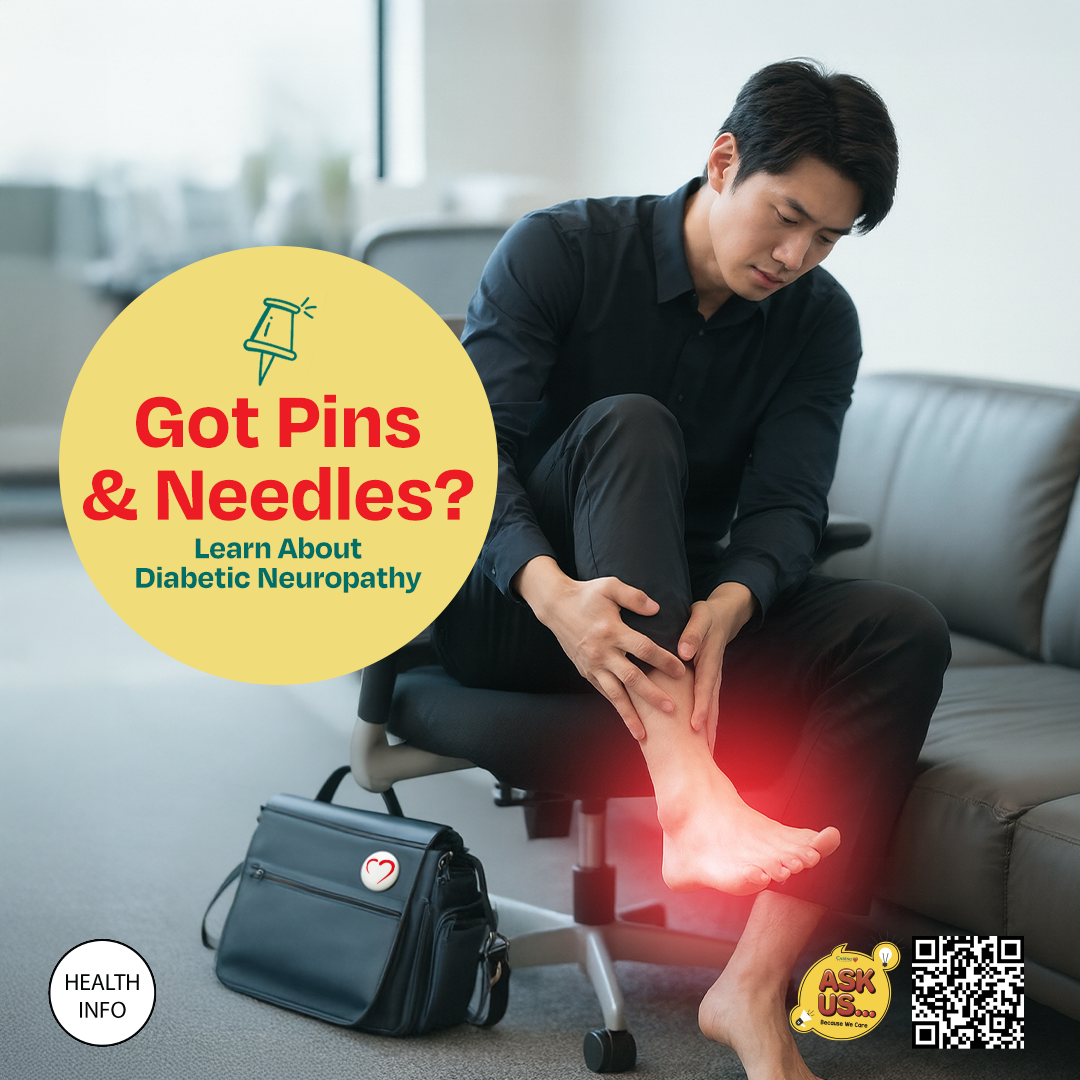- Home
- Health Center
- Health Info
- Got Pins & Needles? Learning about Diabetic Neuropathy
Heart
Got Pins & Needles? Learning about Diabetic Neuropathy


Diabetic neuropathy is a common yet serious complication of diabetes, estimated to affect up to 50% of people with the condition. It occurs due to prolonged high blood glucose which can gradually damage nerves, especially in the hands, legs, and feet.(Tesfaye & Selvarajah, 2012).
Chronically elevated blood sugar contributes to oxidative stress and inflammation, harming the blood vessels that nourish the nerves – over time, this leads to nerve damage. This mainly affects the peripheral nervous system – those nerves located outside the brain and spinal cord, resulting in peripheral neuropathy, the most prevalent form of nerve damage caused by diabetes (Callaghan et al., 2012).
Early signs of diabetic neuropathy may be subtle and often go unnoticed. These can include tingling or “pins and needles,” burning sensations, or numbness in the hands or feet. Pain, often described as either superficial or deep-seated, may worsen at night and disrupt sleep (Bodman, Dreyer & Varacallo, 2025). Neuropathy can progress to cause muscle weakness, unsteady balance, and the development of foot ulcers due to unnoticed injuries. Without proper intervention, severe cases can lead to complications such as infections (Jensen, 2023).
The cornerstone of preventing or slowing down the progression of diabetic neuropathy is proper blood glucose control. In addition, there are several nutritional supplements that can support nerve health and symptom relief.
Alpha-lipoic acid (ALA) is a potent antioxidant that has demonstrated beneficial effects in reducing sensory symptoms associated with diabetic neuropathy. Its anti-inflammatory and neuroprotective properties suggest that ALA could serve as a preventive option in diabetic care (Hsieh, Huang, Chen & Sung, 2023).
Vitamin B12 deficiency is common among individuals with diabetes, particularly those on long-term metformin therapy. B12 supplementation has been shown to improve neuropathic symptoms and also reduce pain in those who have diabetic neuropathy (Karedath et al., 2022).
Acetyl-L-carnitine, another promising compound, may help alleviate neuropathic pain and support nerve regeneration, particularly in individuals with long-standing symptoms. While alpha-lipoic acid and vitamin B12 are often used to manage early or mild symptoms, acetyl-L-carnitine appears more beneficial in cases where nerve damage is more established, and has shown improvements in both pain and nerve fiber density (Sima et al., 2005).
In conclusion, diabetic neuropathy is a potentially debilitating condition, but with early detection, good glucose control, and targeted nutritional support, individuals can significantly reduce the risk of progression and maintain a better quality of life. Visit your nearest CARiNG Pharmacy for more information on diabetic neuropathy and its management.
REFERENCES:
- Diabetic neuropathy: Clinical manifestations and current treatments. Callaghan, B. C., Cheng, H. T., Stables, C. L., Smith, A. L., & Feldman, E. L. (2012). The Lancet Neurology. (Web accessed December 2014). Web link: https://pmc.ncbi.nlm.nih.gov/articles/PMC4254767/
- Effects of Oral Alpha‑Lipoic Acid Treatment on Diabetic Polyneuropathy: A Meta‑Analysis and Systematic Review. Hsieh, R.-Y., Huang, I.-C., Chen, C., & Sung, J.-Y. (2023). Nutrients. (Web accessed July 2025). Web link: https://www.mdpi.com/2072-6643/15/16/3634
- The Impact of Vitamin B12 Supplementation on Clinical Outcomes in Patients With Diabetic Neuropathy: A Meta‑Analysis of Randomized Controlled Trials. Karedath, J., Batool, S., Arshad, A., Khalique, S., Raja, S., Lal, B., Chunchu, V. A., & Hirani, S. (2022). Cureus. (Web accessed July 2025). Web link: https://www.ncbi.nlm.nih.gov/pmc/articles/PMC9704859/
- Acetyl-L-carnitine improves pain, nerve regeneration, and vibratory perception in patients with chronic diabetic neuropathy: An analysis of two randomized placebo-controlled trials. Sima, A. A. F., Calvani, M., Mehra, M., & Amato, A. (2005). Diabetes Care. (Web accessed April 2025). Web link: https://diabetesjournals.org/care/article/28/1/89/25830/Acetyl-l-Carnitine-Improves-Pain-Nerve
- Advances in the epidemiology, pathogenesis and management of diabetic peripheral neuropathy. Tesfaye, S., & Selvarajah, D. (2012). Diabetes/Metabolism Research and Reviews. (Web accessed April 2025). Web link: https://onlinelibrary.wiley.com/doi/10.1002/dmrr.2239
- Diabetic Peripheral Neuropathy. Bodman, M. A., Dreyer, M. A., & Varacallo, M. (2025). StatPearls. (Web accessed July 2025). Web link: https://www.ncbi.nlm.nih.gov/books/NBK442009/?utm_source=chatgpt.com
Tags
Latest Health Info
Brave the Cold: Winter Travel Needs
Winter travel has its kind of magic — snow-covered landscapes, cozy lodges, hot drinks, and festive markets. But traveling in ...
Beat the Heat When Travelling
Whether you’re on a scenic beach vacation or exploring a busy city, hot weather can quickly wear you out and ...
Got Pins & Needles? Learning about Diabetic Neuropathy
Diabetic neuropathy is a common yet serious complication of diabetes, estimated to affect up to 50% of people with the ...


